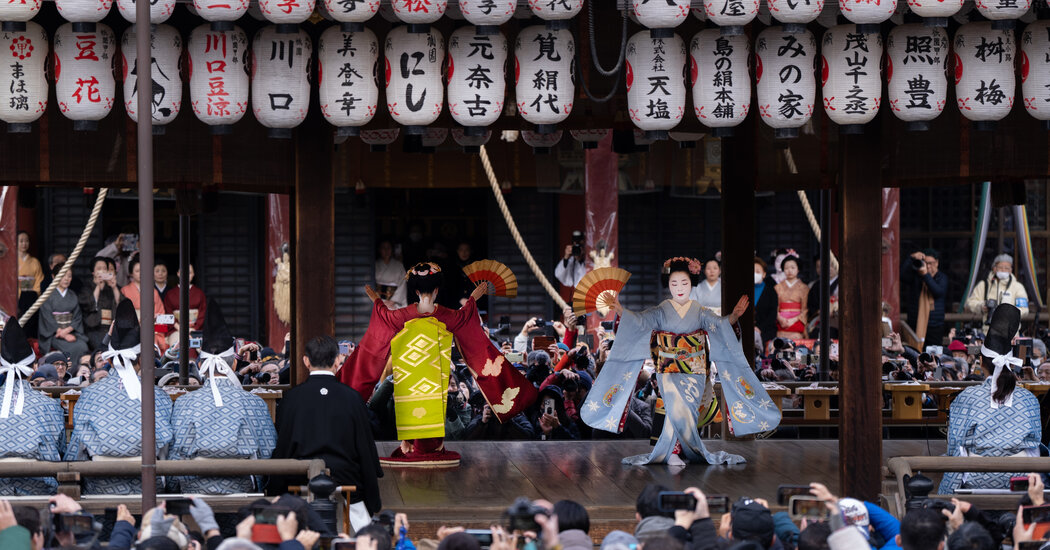As the sun peeked out from the cloudy sky in Kyoto, Japan, monks wearing vests trimmed with pompoms and the black box-like headdresses known as tokin were being quizzed in front of Mibu Dera, one of the oldest temples in the city. These were the Yamabushi (mountain hermits), part of a Buddhist sect known as the Shugendō.
To enter the temple’s sacred area, each monk had to prove he was a real Yamabushi by answering a series of questions about the sect’s beliefs, dress and tools. Only those with satisfactory responses would gain access.
Watching them was a trio of children in light-colored jackets, with six curious eyes trying to figure out what was going on, joined by me, a Korean American photographer with two big eyes filled with the same curiosity.
They were preparing for the Goma Fire Ritual, as part of the Setsubun Matsuri or Setsubun Festival, held on the day before the beginning of spring, according to the Asian lunar calendar. For ages, Japanese people have used the change of seasons to exorcise past misfortunes and offer prayers for future safety and prosperity. In Kyoto, Setsubun festivals are held at many of the city’s temples and draw crowds of thousands who celebrate a variety of rituals to bring good fortune and ward off evil spirits.
The children and I soon followed the monks into the grounds of the Mibu Temple where a pile of hinoki, or cypress leaves, was ready in front of the main hall for the Goma Fire Ritual.
The monks initiated the ritual with loud drumming, the blowing of the gigantic Horagai conch shell and chanting, as they ignited a fire to burn the hinoki leaves and gomagi, wooden sticks symbolizing human desires (the root of suffering) that had been added to the pile. The fire would ward off evil spirits for the coming year. An enormous cloud of smoke rose before the main hall and the nearby Thousand Body Stupa, which contains exactly 1,000 statues of Amida Nyorai, or the Buddha of Limitless Light, and Jizo, a bodhisattva known for compassion.
Busy junior monks poured buckets of water around the pyre as the earsplitting drums echoed and the roaring fire swallowed everyone’s bad luck.
As the senior monks chanted and prayed, the unruly orange fire was kept in check with the help of the sweating junior monks who poured buckets of water around its perimeter.
At the Yoshida Jinja or Yoshida Shrine, the highlight of the day was the Tsuina-shiki ceremony, when a devil-god named Hososhi, from ancient China, with four golden eyes and a horn, wielded a massive spear and shield and let out bloodcurdling wails as he drove away red, blue and yellow oni, a kind of demon in Japanese folklore. Children in white robes held burning torches to light the action. Around them, firefighters were busy extinguishing the embers dropped from the torches.
For Setsubun, people also scatter soybeans, which are said to chase away evil spirits, in a ritual called Mame Maki, often while shouting, “Oni wa soto! Fuku wa uchi!” (“Devils out! Good luck in!”). People also toss old good-luck amulets onto a giant bonfire in a ceremony known as Karo-sai.
Among the crowds who lined up at the Yoshida shrine as early as three hours before the Tsuina-shiki ceremony, one of the youngest was Miu Imamura, 4, from Kyoto, who was wearing a homemade oni mask pushed up onto her forehead, as she and her sister lined up with their mother, Yuina Imamura, to buy lucky beans known as fuku-mame. At Setsubun, children traditionally make and wear oni masks, though the tradition seemed to be dying out. ‘
Prayers for the new year are also part of the day. At Mibu, Yasuko Isoda, a native Kyotoite, prayed for her family’s safety and for the people who were affected by the Noto earthquake. Ms. Imamura, the mother of the girl with the oni mask, prayed for her family’s health and no disasters for everyone in 2024.
After the Tsuina-shiki, people started to line up to get a chance to receive hamaya, or holy arrows, from a miko or shrine maiden, who danced while carrying arrows in one hand and a bell in the other. Many of the arrows were later placed on a bonfire to be burned for good luck.
Yoshida Shrine’s Setsubun Festival is one of the biggest in Kyoto and there are more than 800 food stalls at the entrance and within the festival. During the festival, visitors endlessly brought their own amulets to be burned and volunteers piled the amulets into a gigantic tower for the Karo-sai ceremony. At 11 p.m. on the night of Setsubun, the shinshoku, or Shinto priests lit the amulet-filled tower with their torches from both sides and let the amulets and the gods within them be free and return home.
The bonfire raged, consuming the amulets and the holy arrows, seemingly granting the wishes of those who’d brought them to throw on the fire, and inaugurating the Year of the Blue Dragon, with a grand finale.







